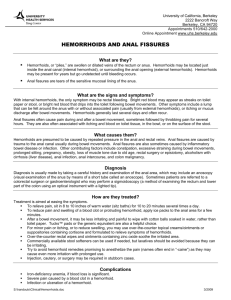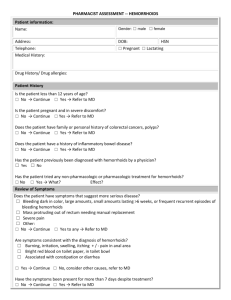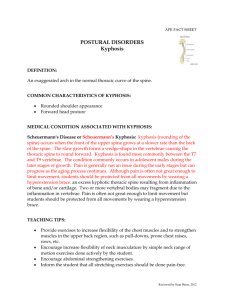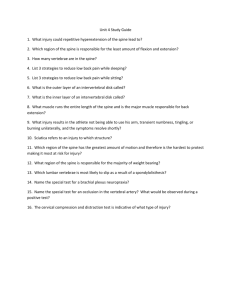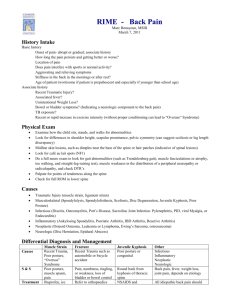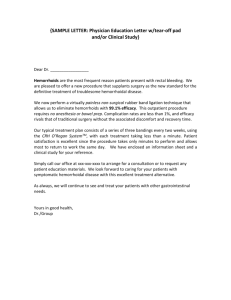幻灯片 1
advertisement
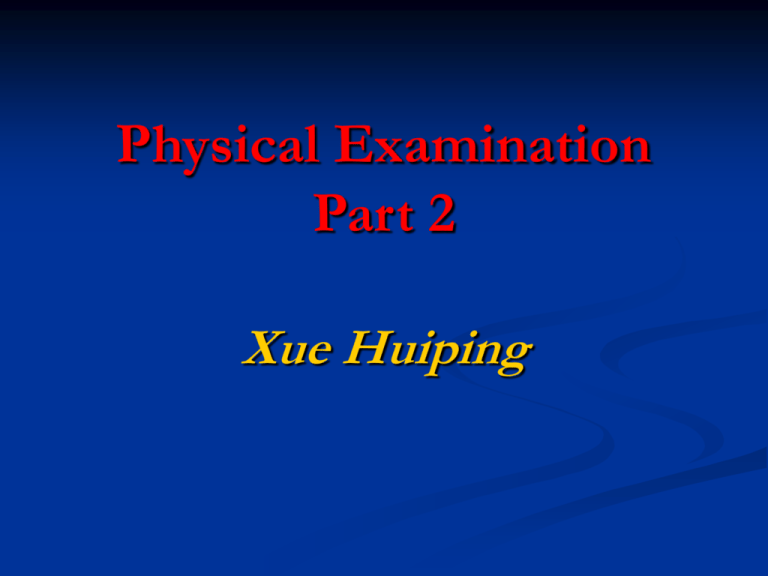
Physical Examination Part 2 Xue Huiping Male reproductive anatomy This illustration represents an average normal adult human penis. The head of the penis (glans) has a covering, called the foreskin (prepuce). This covering folds in on itself, forming a double layer. The foreskin is not a `flap' of skin on the end of the penis, and it is not `useless' or `redundant' skin. There is some natural variation in the length of the foreskin, which often covers a bit more or less of the glans than illustrated. In an average circumcised adult man, the area of skin that is missing because of penile reduction surgery would, when erect and unfolded, measure approximately three by five inches, or a little smaller than a postcard. That is about half the total skin of the penis. Structures of the penis The outer foreskin layer is a continuation of the skin of the shaft of the penis. The inner foreskin layer is not properly `skin', but mucocutaneous tissue of a unique type found nowhere else on the body. The frenar band is the interface (join) between the outer and inner foreskin layers. When the penis is not erect, it tightens to narrow the foreskin opening. During erection, the frenar band forms a ridge that goes all the way around, about halfway down the shaft. The reddish or purplish glans or glans penis (head of the penis) is smooth, shiny, moist and extremely sensitive. The frenulum, or frenum, is a connecting membrane on the underside of the penis, similar to that beneath the tongue. Here is a normal testis and adjacent structures. Identify the body of the testis, epididymis, and spermatic cord. Note the presence of two vestigial structures, the appendix testis and the appendix epididymis. On the left is a normal testis. On the right is a testis that has undergone atrophy. Bilateral atrophy may occur with a variety of conditions including chronic alcoholism, hypopituitarism, atherosclerosis, chemotherapy or radiation, and severe prolonged illness. A cryptorchid testis will also be atrophic. Inflammation may lead to atrophy. Mumps, the most common cause for orchitis, usually has a patchy pattern of involvement that does not lead to sterility. Here is a large hydrocele of the testis. Such hydroceles are fairly common. Clear fluid accumulates in a sac of tunica vaginalis lined by a serosa with a variety of inflammatory and neoplastic conditions. A hydrocele must be distinguished from a true testicular mass, and transillumination may help, because the hydrocele will transilluminate but a testicular mass will be opaque. 完全型具有正常女性体征,有正常女性外 阴且发育良好(但阴毛稀少或缺如),阴 道发育良好,深度正常。青春期后乳房可 发育。不完全型外阴有不同程度的畸形, 阴蒂增大,阴道短浅或呈尿生殖窦。睾丸 多位于腹股沟内。 Epididymis附睾 The epididymides (plural for epididymis 附睾) are narrow, elongated storage vessels for newly generated spermatozoa. They are located within the scrotum阴囊, adjoining each testicle睾丸. Spermatozoa 精子remain in the cord-like epididymides附睾 until ejaculation, at which time they eject them into the vas deferens输精管. Cryptorchidism隐睾病 Cryptorchidism is defined as failure of the testis to descend from its intra-abdominal location into the scrotum. Epididymis 附睾 A long, narrow, convoluted tube, part of the spermatic duct system, that lies on the posterior aspect of each testicle, connecting it to the vas deferens. Elephantiasis象皮肿 of the scrotum scrotal hernia an inguinal hernia腹股沟疝 which has descended into the scrotum. The Prostate Gland 前列腺 The prostate is a walnut-sized gland that forms part of the male reproductive system. The gland is made of two lobes, or regions, enclosed by an outer layer of tissue. As the diagrams show, the prostate is located in front of the rectum and just below the bladder, where urine is stored. The prostate also surrounds the urethra尿道, the canal through which urine passes out of the body. Normal urine flow Seminal Vesicle produces a mucoid secretion that's released into the semen精液 Female reproductive anatomy External Genitalia External organs include the sensitive and erotic sex organs: mons pubis, labia唇 and clitoris阴 蒂 (also known collectively as the vulva外阴), and the breasts. The Mons Pubis The mons pubis (sometimes called the mons veneris after Venus, the Roman goddess of love) is the region of fatty tissue above the pubic bone. At puberty, the mons pubis enlarges and becomes covered by pubic hair. The Labia Often referred to as "lips," the labia are the fold of tissue surrounding the vaginal and urethral openings, protecting the sensitive orifices from damage. The outer, fleshy hair-covered folds form the labia majora and the inner hairless folds form the labia minora. The labia are rich with nerve endings and generally respond well to stimulation. The Clitoris 阴蒂 The female glans (the male glans is the penis), the clitoris is extremely sensitive and engorges with blood during sexual arousal. Protected by the clitoral hood, the clitoris is above the urethral opening and below the clitoral shaft, which has two arms (called crura) that stretch backwards into the woman's body, under the skin on either side above the vaginal opening. Nerves controlling clitoral muscle contractions travel alongside the walls of the vagina阴道, the bladder and urethra, passing along the sensations produced in any part of Internal Structures Internal organs include the uterus子宫, Fallopian tubes输卵管 and ovaries卵巢, which contain the female’s sex cells: the ova, or eggs. The Ovaries The ovaries are paired structures, approximately the size of a walnut, that are anchored to the body cavity and to the uterus by strong cord-like structures known as ligaments. The ovaries contain the ova and produce the female sex hormones estrogen and progesterone孕 酮. The Fallopian Tubes The Fallopian tubes, also called the uterine tubes or oviducts, extend from the uterus up around the ovaries. The Fallopian tubes display muscular contractions that help draw the ovum into the uterus. The upper portion of the tubes is where fertilization of an ovum by a sperm commonly occurs; if the zygote does not move down into the uterus, an ectopic pregnancy occurs, which can be fatal to the mother and must be terminated. The Fallopian tubes are surgically altered when a woman undergoes the sterilization procedure known as a tubal ligation. The Uterus The uterus (or womb) is a pear-shaped multilayered organ located at the base of the pelvic cavity. The opening of the uterus, known as the cervix子宫颈, contains a narrow opening that serves as a passageway for menstrual flow or for a fetus to exit the vagina. The innermost layer of the uterus is the endometrium, which is partially shed with each the menstrual flow. The uterus can be host to a number of sexual health problems, including endometriosis子 宫内膜异位, cervical cancer and uterine cancer. The Vagina The vagina is a three to four-inch long, thin-walled mucous-lined tube. In addition to providing an exit for menstrual blood or a fetus, the vagina is the reception site for the penis during intercourse. Anus and Rectum Exam ♣ Patient position and preparation Left lateral decubitus position Assistant or patient spreads glutei ♠ Findings on Inspection Anal Fissures 肛裂 Anal fistula 瘘 Perianal肛周的 dermatitis Anal mass External Hemorrhoid 外痔 Condyloma 湿疣 ♣ Rectal examination Digital Rectal Exam Anoscopy 肛门镜检查术 WHAT IS AN ANAL FISSURE? An anal fissure is a small tear or cut in the skin lining the anus which can cause pain and/or bleeding. A thin slit-like tear in the anal tissue, an anal fissure is likely to cause itching, pain, and bleeding during a bowel movement. The typical symptoms of an anal fissure are extreme pain during defecation and red blood streaking the stool. Patients may try to avoid defecation because of the pain. How is it diagnosed? The diagnosis of an anal fissure is made by examination of the anus and anal canal. The tear usually is easy to see, although occasionally a small viewing instrument, called an anoscope, may be used in the evaluation. What Are Hemorrhoids 痔? The term hemorrhoids refers to a condition in which the veins around the anus or lower rectum are swollen and inflamed. Hemorrhoids may result from straining to move stool. Other contributing factors include pregnancy, aging, chronic constipation or diarrhea, and anal intercourse. Hemorrhoids are either inside the anus (internal) or under the skin around the anus (external). What Are the Symptoms of Hemorrhoids? Although many people have hemorrhoids, not all experience symptoms. The most common symptom of internal hemorrhoids is bright red blood covering the stool, on toilet paper, or in the toilet bowl. However, an internal hemorrhoid may protrude through the anus outside the body, becoming irritated and painful. This is known as a protruding hemorrhoid. Internal hemorrhoids occur higher up in the anal canal, out of sight. Bleeding is the most common symptom of internal hemorrhoids, and often the only one in mild cases. Sometimes, internal hemorrhoids will come through the anal opening when straining to move your bowels. This is called a prolapsed脱垂 internal hemorrhoid; it is often difficult to ease back into the rectum, and is usually quite painful. Symptoms of external hemorrhoids may include painful swelling or a hard lump around the anus that results when a blood clot forms. This condition is known as a thrombosed external hemorrhoid. In addition, excessive straining, rubbing, or cleaning around the anus may cause irritation with bleeding and/or itching, which may produce a vicious cycle of symptoms. Draining mucus may also cause itching. External hemorrhoids are visible-occurring out side the anus. They are basically skin-covered veins that have ballooned and appear blue. Usually they appear without any symptoms. When inflamed, however, they become red and tender. When a blood clot forms inside an external hemorrhoid, it often causes Severe pain. This thrombosed external hemorrhoid can be felt as a firm, tender mass in the anal area, about the size of a pea. Extremities and Articulus Koilonychia反甲 Fingernail Nail Abnormality Signs Concave凹的 or Spoon shaped nails Associated Conditions ♥ Anemia ♥ Thyroid甲状腺 dysfunction ♥ Trauma ♥ Impaired peripheral circulation ♥ Familial 家族性的 ♥ Normal finding in infants Koilonychia may be caused by or feature of (sorted by category) ♪ Autosomal dominant conditions Steatocystoma皮脂腺囊瘤multiplex ♪ Nutritional conditions Iron deficiency The nails are flattened and have concavities. This condition may be associated with iron deficiency. acropachy 杵状指 "Clubbing" of the fingers with thickening of skin at the base of the nails, often with an increase in the curvature of the nails. Acromegaly 肢端肥大症 Acromegaly is the Greek word for "extremities" and "enlargement." When the pituitary gland produces excess growth hormones, this results in excessive growth -- called acromegaly. The excessive growth occurs first in the hands and feet, as soft tissue begins to swell. Acromegaly affects mostly middleaged adults. Untreated, the disease can lead to severe illness and death. Acromegaly - Hands - Normal female hand for comparison genu valgum 膝外翻, a deformity in which the knees are abnormally close together and the space between the ankles踝关节 is increased; known also as knock knee. genu varum膝内翻, a deformity in which the knees are abnormally separated and the lower extremities are bowed inwardly; the deformity may be in the thigh or leg, or both. Known also as bowleg. (A), Genu varum; (B), genu valgum. genua [ plural of genu ] Genu valgum Genu varum Standing radiograph in a child with hypophosphatae m-ic rickets demonstrating genu varum. Flatfoot Definition Foot medial longitudinal arch depression or loss Associated conditions Heel足跟 eversion外翻 (valgus) Forefoot前足 abduction外展 Muscular atrophy Muscular atrophy is the decrease in size and wasting of muscle tissue. Muscles that lose their nerve supply can atrophy and simply waste away. Skeletal spine The spine is divided into several sections. The cervical vertebrae make up the neck. The thoracic vertebrae comprise the chest section and have ribs attached. The lumbar vertebrae are the remaining vertebrae below the last thoracic bone and the top of the sacrum骶骨. The sacral vertebrae骶椎 are caged within the bones of the pelvis骨盆, and the coccyx尾骨 represents the terminal vertebrae or vestigial残迹的 tail. Kyphosis 脊柱后凸 Kyphosis is a curving of the spine that causes a bowing of the back, such that the apex of the angle points backwards leading to a hunchback驼背 or slouching posture. Kyphosis is a spinal deformity that can result from trauma, developmental problems, or degenerative disease. Kyphosis can occur at any age, although it is rare at birth. Adolescent kyphosis, also known as Scheuermann's disease, results from the wedging together of several consecutive vertebrae (bones of the spine). The cause of Scheuermann's disease is unknown. In adults, kyphosis can be a result of osteoporotic compression fractures (fractures caused by osteoporosis), degenerative disease (such as arthritis), or spondylolisthesis脊椎前 移(slipping of one vertebra forward on another). Symptoms Mild back pain Fatigue Tenderness and stiffness in the spine Round back appearance Difficulty breathing (in severe cases) Signs and tests Physical examination by a health care provider confirms the abnormal curvature of the spine. The doctor will also look for any neurologic changes (weakness, paralysis, or changes in sensation) below the level of the curve. A spine X-ray will be done to document the severity of the curve and allow serial measurements to be performed. Occasionally, pulmonary function tests may be used to assess whether the kyphosis is affecting breathing. If there is any question of a tumor, infection, or neurologic symptoms, then an MRI may be ordered. Lordosis 脊柱前凸 Lordosis is excessive curvature in the lumbar portion of the spine, which gives a swayback 背部过份 凹陷appearance. The spine has three types of curves: Kyphotic, which typically refers to the outward curve of the thoracic spine (at the level of the ribs) Lordotic, which refers to the inward curve of the lumbar spine (just above the buttocks) Scoliotic, which is a sideways curvature of the spine and which is always abnormal What is scoliosis? Scoliosis is an abnormal curve of the spine (backbone). With scoliosis, the spine isn't straight. Instead, the spine is crooked and curves to the side. If the spine is very crooked, the ribs or hips may stick out more on one side than the other side. Also, one shoulder may be lower than the other. 脊柱侧凸 Inside the Knee The knee is designed for its own protection. It's completely surrounded by a joint capsule that's flexible enough to allow movement but strong enough to hold the joint together. The capsule is lined with synovial滑液的;滑膜的tissue, which secretes synovial fluid to lubricate the joint. Wearresistant cartilage软骨 covering the ends of the thighbone股骨(femur) and shinbone胫 骨 (tibia) helps reduce friction during movement. Pads of cartilage (menisci) act as cushions between the two bones and help distribute body weight in the joint. Fluidfilled sacs (bursas囊) provide cushioning as skin or tendons move across bone. Ligaments along the sides and the back of the knee reinforce the joint capsule, adding stability. The kneecap (patella髌 骨) protects the front of the joint. Thanks!
